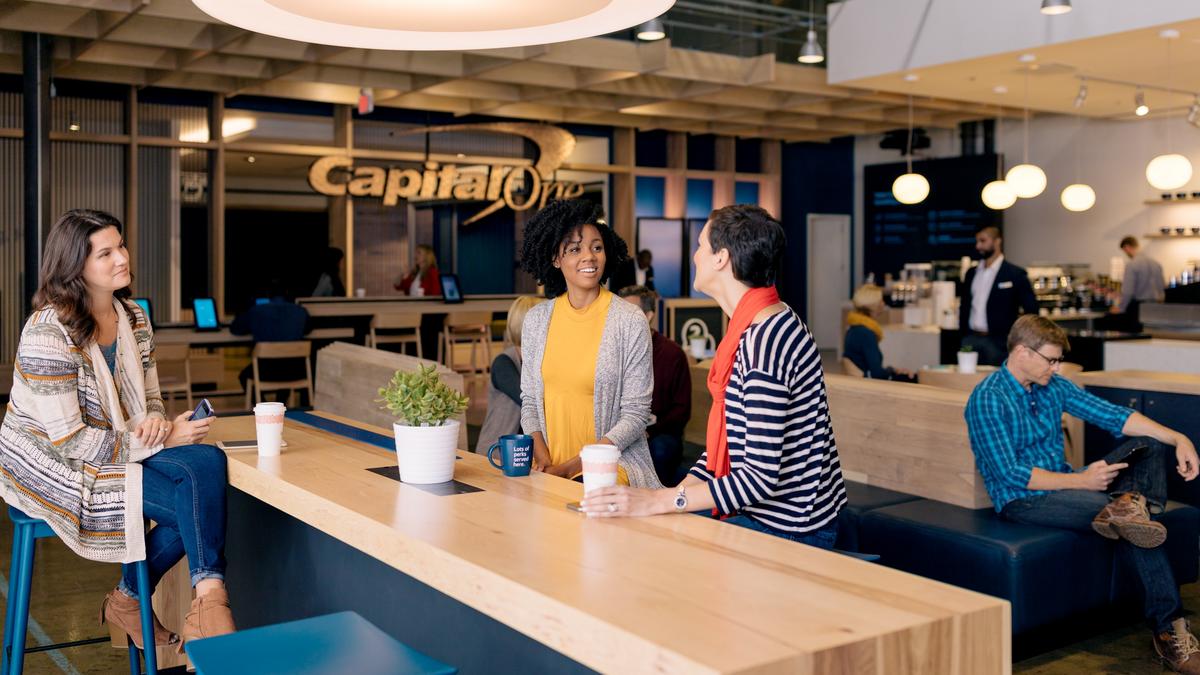This post took me in a direction that I didn’t expect to go. I planned to highlight a strategic error, explain the importance of knowing your core business, and make recommendations about business decision making. But in retrospect, while researching Capital One Cafés, I learned about an obvious and long-term banking trend that is having negative impacts. As it turned out, Capital One Cafés are an interesting attempt to address those trends. But Capital One’s approach also raises real concerns about communities getting left behind economically.
Bank Branches Disappearing
Most of us intuitively understand why bank branches are declining. Personally, I don’t go to the bank unless I have a question too hard for the banking app to answer. That usually means opening an account, getting a cashier’s check, or helping my dad’s business by depositing some checks. Since all of this can be accomplished online these trips to the bank are rare.
This is a common approach to banking. “Roughly three in four Americans (76%) have used their primary bank’s mobile app within the last year for everyday banking tasks like depositing checks or viewing statements and account balances, according to the Ipsos-Forbes Advisor U.S. Weekly Consumer Confidence Survey.”[1] However, when things get complicated, people rely on branches to get in-person expert advice on home-buying, small business loans, retirement planning, etc. As U.S. Bancorp CEO Andy Cecere said in 2020:

This is further supported by data showing “nearly one-third of U.S. consumers either switched banks or started using a different financial institution after their main branch closed.”[3]
Despite this continued love for branches, banks are shutting them down at a good pace. At its peak, in 2008 the United States had 102,630 bank branches.[4] Beginning with the 2008 Financial Crisis, banks began closing branches and, with few exceptions, branch closures have only accelerated. The ongoing pandemic further fueled this trend by pulling even more foot traffic out of banks, which led to 3,492 branch closings in the last two years. This is the highest number of branch closures in any two-year period since 2001. Since 2008, the U.S. has lost roughly 13% of its bank branches with no real end in sight. One group even speculated that bank branches will go extinct by the year 2034.[5]
While total extinction is a strong prediction, you cannot deny that the economics for it are there. In 2017, it was estimated that new branches require $2-4 million in setup costs and between $200-400k in annual operating costs thereafter.[6] And pushing app activity is extremely more profitable. “Bain estimates that every interaction a consumer has with a teller or agent at a call center costs the organization $4; by contrast, mobile interactions cost only 10¢ each.”[7] In other words, banks will happily close branches and smile all the way to the bank (themselves?) after doing so. Therefore, banks will seek the highest profitable mix of purposeful branch footprint and branch closures. And, so far, they’re still figuring out what that mix is.
Capital One Cafés- A Potential Step Forward, A Potential Major Step Back
The Strategy
Capital One is known for building analytics-based strategies. In their words, via some sponsored Harvard Business Review content:

In other words, Capital One looks at the data.
The data on Capital One shows it has become the foremost example of closing branches. Capital One closed 321 branches from 2017-2021.[9] JPMorgan Chase closed 311 branches, and Bank of America closed 379 branches in the same period. [10] These are very similar closure numbers, despite the two banks operating 8x and 7x the branch locations than Capital One in 2017, respectively. All in all, Capital One closed 50.1% of its branches between 2017 and 2021; no other bank would close more than 26.8% of their branches during the same period.
At around the same time, Capital One Cafés began popping up on the map. In 2015, Capital One opened its first café in Boston.[11] Since then, it has grown to “almost 50 Capital One Cafés around the country, and that number is set to grow in 2022.”[12] In crafting the Capital One Café experience, Capital One looked at the data once again:

The café provides human resources to facilitate more complex financial conversations and customer service. Furthermore, by creating a consistent touch point at the café, Capital One positions itself to be there as latent consumer needs become urgent. For context: That business plan you’ve been working on at the café for the past 6 months? Simply get up from the high-top table and talk to a loan officer on the couch. Additionally, cafés are brand marketing that grant interactive access to consumers at the bank. Somewhat surprisingly, this is actually an excellent plan to take advantage of the overall branch decline. Especially, assuming they spent $2M per cafe, their costs were approximately $100M,[14] over the last 7 years for rollout. Meaning it was around .3% of last year’s net revenue.[15]
The Problem
Capital One Cafés’ approach is fascinating, but it could harm “low-to-moderate income and minority neighborhoods.”[16] Per the National Community Reinvestment Coalition (“NCRC”), “[o]ne-third of the branches closed from 2017 to 2021 were in a low-to-moderate-income and/or a majority-minority neighborhood where access to branches is crucial to ending inequities in access to financial services.”[17] When branches close down, small business lending declines, and people turn to more predatory financial services like payday lending.[18] These banking deserts[19] deprive communities of economic opportunity and sound financial advice from bankers who are connected to those communities.
Your immediate thought might be that one-third of branches closed is not too bad given the general trend. However, as NCRC points out, looking at this problem on a percent change or absolute number basis is misleading. These neighborhoods were operating on a smaller branch base to begin with.[20] Even the smallest change can cut sharply into the economic opportunity available and add to the challenges that these communities face. You might also wonder why these conversations just can’t happen online. But you must remember: 1) the human connection is highly desired to navigate complexities and 2) these communities often have unequal access to broadband or adequate technologies.[21]
If Capital One is a leading indicator, then there is real cause for concern. Capital One Cafés haven’t opened in communities of need. Of the 49 café locations I could identify, 57% are in zip codes where the annual median income is over $80,000.[22] 37% are in zip codes with annual median income over $100,000. The other locations are generally in malls, parks, or downtown districts where higher income people are likely to gather and spend time.

(They also have very upscale & location specific design.)
If this becomes the dominant branch banking strategy, then we’ll see closures in disadvantaged neighborhoods while the branch model is specifically relegated to locations in upper-middle to high-income areas. In other words, the profitable mix between branches and online activity will remain askew from those in the most need of solid banking.
In fairness, we are still in the early years of this branch banking evolution. It is entirely possible that Capital One and other banks are following the common rollout approach for almost all new concepts, which is to target higher income consumers before mass distribution. Capital One might ultimately put cafés in every type of zip code and/or find interesting partnerships to provide services in communities of need. However, given the financial industry’s history of limiting opportunity via geography (read: redlining), in conjunction with the profit motive I wouldn’t assume that this is the plan.
At that point, Congress and regulatory agencies must be ready to step in and assist these neighborhoods. Programs to pilot basic banking at postal services are underway.[23] This will solve some problems by providing a safe alternative to predatory financial services. However, it is facing Republican opposition, leaving the future of this program unclear.[24] Rep. Maxine Waters has introduced legislation that would allow credit unions to serve banking deserts.[25] However, this is opposed by the American Bankers Association.[26] But as B. Dan Berger, the president and CEO of the National Association of Federally-Insured Credit Unions, points out:

Banking institutions have a long-standing concern about credit unions because, in opposition, credit unions can offer better savings and interest rates.[28] However, credit unions are limited in terms of scale and reach, and the banks reflexively oppose any credit union scope expansion. In this case the banking industry is literally ceding the ground in banking deserts while fighting against efforts to fill the void they created. All considered, legislation will likely be the only way to fulfill the needs in banking deserts.
Conclusion
Capital One Cafés are a surprisingly good and data-supported corporate play. But their deployment highlights a concerning trend around banking desert growth. If all banks follow their lead, the low-to-moderate income and majority-minority neighborhoods will be left behind. This is an outcome supported by banking history and profit motives.
I can’t fault the banks for pursuing ideas to find the right mix of in-person and digital banking. But I don’t think they should create banking deserts and actively oppose attempts to fill them. If banks are incentivized to pull branches out of these neighborhoods then as citizens we have the right to legislative solutions that will further promote economic equality and fair banking practices for all who get left behind.
Sources:
[1] https://www.forbes.com/advisor/banking/digital-banking-survey-mobile-app-valuable-features/
[2] https://seekingalpha.com/article/4393879-u-s-bancorp-usb-ceo-andy-cecere-presents-goldman-sachs-u-s-financial-services-virtual
[3] https://cxfinance.wbresearch.com/blog/capital-one-cafe-a-blueprint-for-the-modern-branch-strategy
[4] https://www.federalreserve.gov/econres/notes/feds-notes/bank-branches-and-covid-19-where-are-banks-closing-branches-during-the-pandemic-accessible-20211217.htm#fig1 (full article: https://www.federalreserve.gov/econres/notes/feds-notes/bank-branches-and-covid-19-where-are-banks-closing-branches-during-the-pandemic-20211217.htm#:~:text=From%202019%20to%202020%2C%20there,although%20by%20a%20smaller%20amount.) (Author Note: I noticed that 5,973 bank branches closed in 2001, which is the biggest single year ever. It is out of scope to research this dip, but I may return to it in a “Quick Thought” later on. All calculations on branches are based on this data.)
[5] https://www.foxbusiness.com/markets/bank-branches-to-disappear-2034-research
[6] https://futurebranches.wbresearch.com/blog/capital-one-combines-coffee-with-banking-to-cater-to-millennials
[7] See note 3.
[8] https://hbr.org/sponsored/2021/02/how-capital-one-moved-its-data-analytics-to-the-cloud#:~:text=Analytics%20is%20at%20the%20heart,its%20customers%20manage%20their%20finances.
[9] https://ncrc.org/the-great-consolidation-of-banks-and-acceleration-of-branch-closures-across-america/
[10] See note 9.
[11] https://www.wsj.com/articles/is-this-a-coffee-shop-or-a-bank-1436225586
[12] https://www.fastcompany.com/90710664/how-a-coffee-shop-concept-helped-a-credit-card-company-transform-into-a-consumer-friendly-financial-institution (Author Note: I counted 49 on a Google search and from what I could find on the Capital One location finder.)
[13] See note 12.
[14] I’m going off the $2-$4M range for starting branches quotes earlier, and I’m using this headline from the Atlanta Business Journal about the Lenox Mall location costing over $2M (https://www.bizjournals.com/atlanta/news/2019/05/14/capital-one-cafe-coming-to-lenox-square-mall-will.html). If you are thinking that the $100M estimate is low, just keep in mind that you can double it, and it still won’t likely be material spend for Capital One. And ongoing operating costs will be lower going forward annually than the set-up. There is a lot of runway with this approach.
[15] Calculated from Capital One’s 2021 Annual Report on Form-10-K
[16] See note 9.
[17] See note 9.
[18] See note 9.
[19] See note 4 (to read an in-depth breakdown of banking deserts).
[20] See note 9.
[21] https://www.pewresearch.org/fact-tank/2021/07/16/home-broadband-adoption-computer-ownership-vary-by-race-ethnicity-in-the-u-s/
[22] For this, I used census data at: https://www.census.gov/programs-surveys/geography/guidance/geo-areas/zctas.html
[23] https://www.aarp.org/money/investing/info-2022/restarting-postal-banking-services.html
[24] https://www.oleantimesherald.com/news/gop-senators-oppose-idea-of-post-office-banking-services/article_c508cba8-3297-5195-8325-57da550a665a.html
[25] https://www.nafcu.org/newsroom/nafcu-supported-bill-allowing-cus-add-underserved-areas-fom-introduced-house
[26] https://www.aba.com/advocacy/policy-analysis/joint-sba-letter-to-hfsc-opposition-to-hr-7003#_ga=2.36230176.1691677642.1650389819-2064918875.1649862546
[27] https://www.americanbanker.com/opinion/waters-proposed-legislation-would-benefit-under-banked-communities
[28] https://www.experian.com/blogs/ask-experian/what-are-the-benefits-of-a-credit-union/




Thanks for highlighting this trend how limiting access to wealth and financial services upholds ongoing socioeconomic divides. Even once policies are changed or laws passed, the damage done by financially discriminatory policy affects the well-being of many marginalized populations for generations to come.